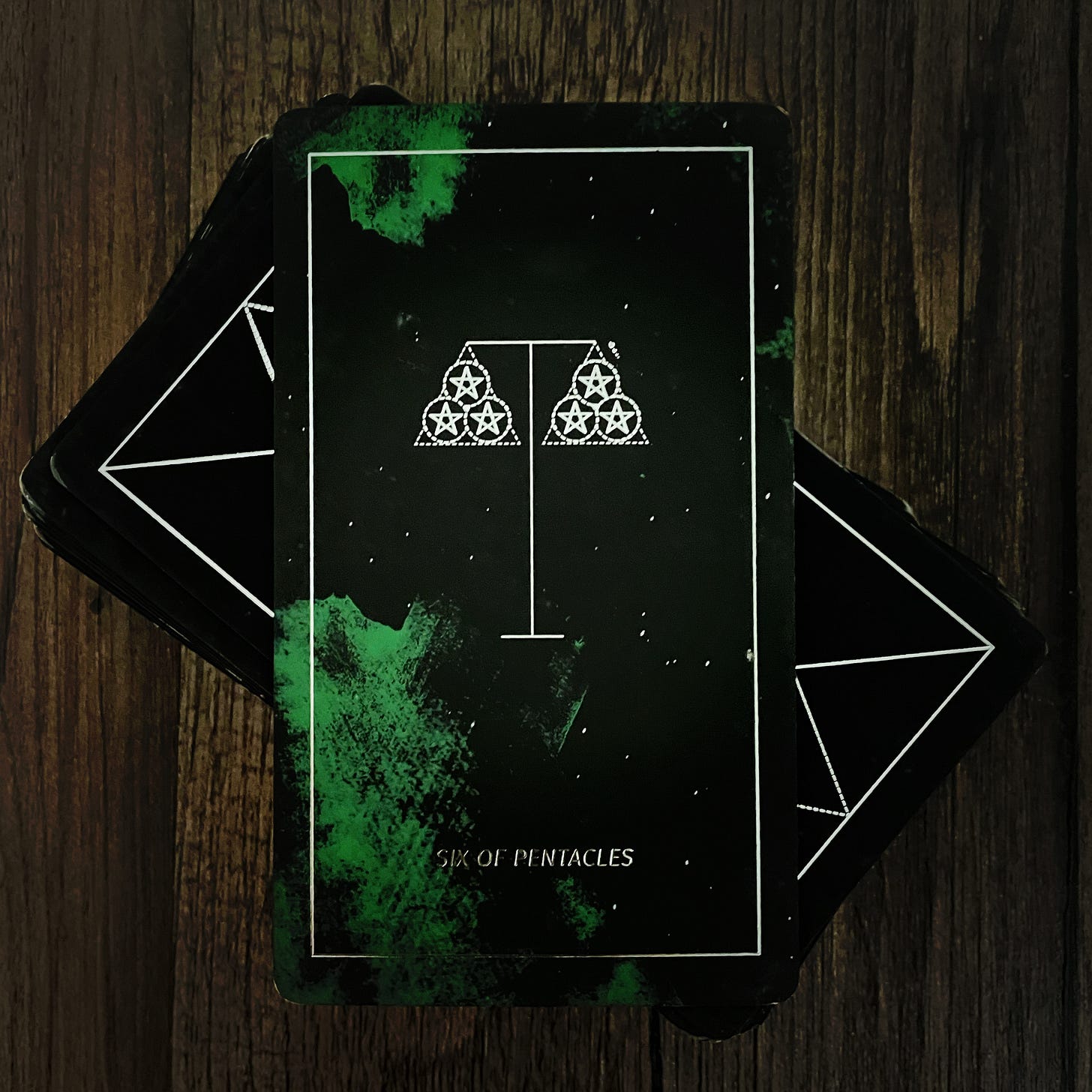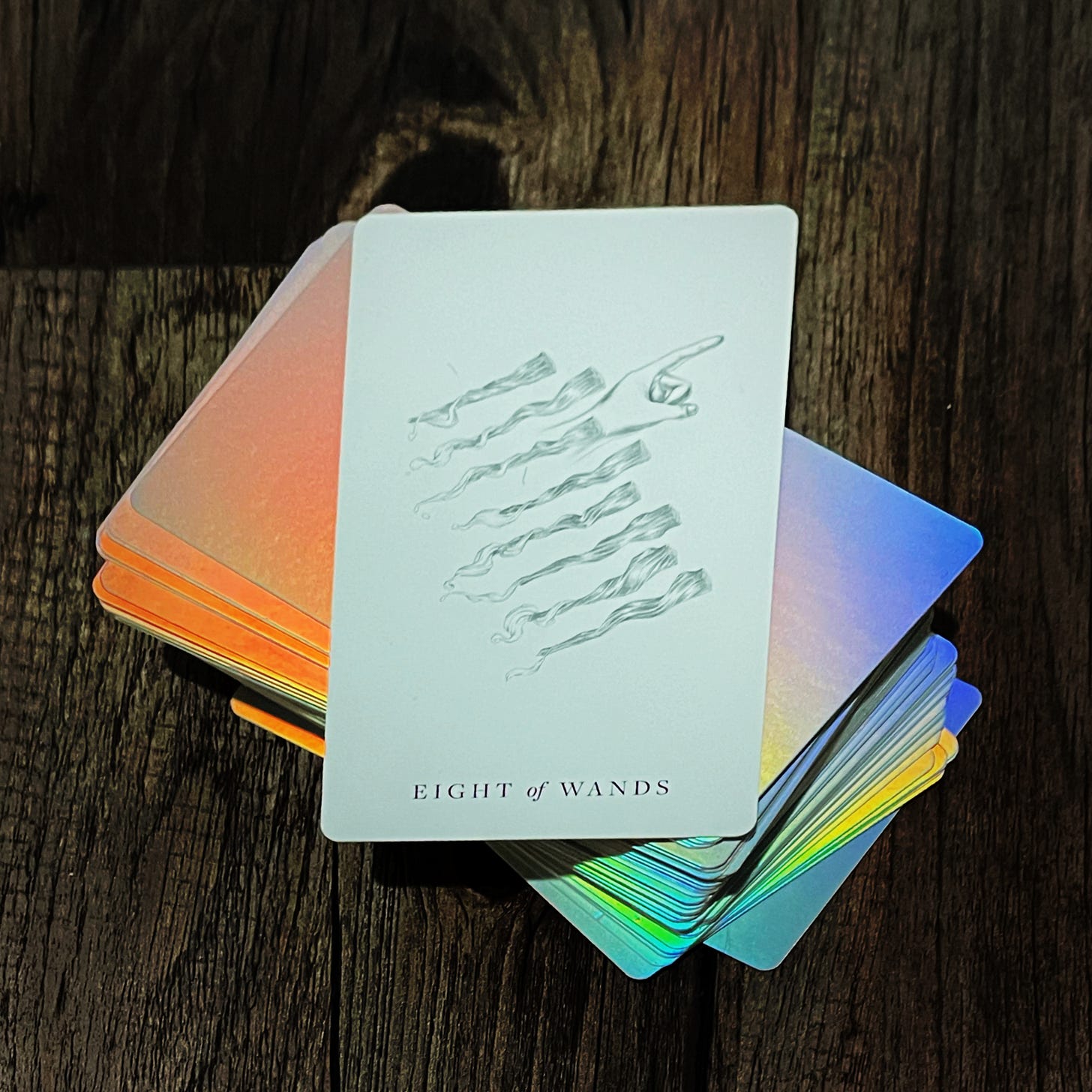MISSIVE 50
Heuristics for Reading Minor Arcana
The language of Tarot, to me, is a shorthand expression of human experience. A deck can have seventy-eight cards, or seventy-nine, or replace swords with needles, and still be a proper Tarot deck, as the heuristics which define the Art are adaptable to the creativity of individual artists and the capabilities of publishers. A widely-used deck can swap the robed Hermit with his lantern for an octopus and not disrupt the ability of that deck to be read; in fact, Tarot as a whole is informed by the contemplation of what nuance cephalopod biology adds to the subtleties of the nines.
As a reader becomes familiar with multiple decks, there is a substructure of forms which have their own contours and textures that transcend any one artist, yet engage in perpetual dialectic with the human experiences that they indicate. There is no secret truth or “perfect” interpretation: Tarot grows with us. Individual artistic expressions in the cards fold over this substructure of forms like papier-mâché over a frame: never quite exact, yet revealing something more about what each arcanum presently articulates. The sum total of human experiences are constantly producing feedback that shapes the Art, and Tarot as a whole continues to fold around them.
Below are some of my own observations surrounding the contours of each of the minor suits across decks, and how they reflect on humanity overall. Thinking about each of these in the context of the cards under its auspice has been helpful to me as a reader, and I hope it will be for you as well. I will temporarily be using various decks as examples that allow the implements of the minors to perform the drama of the card, rather than those with personified images.
—
1. COINS (PENTACLES)
A coin tends to be a standard unit of conceptual value assigned to a standard unit of material, typically earthen. Nothing articulates our imperfect systems of weights and measures more fully than this unitary assignment that forces the question of what some individual thing means to us relative to any other. The very word economy derives from oikonomia, which literally translates to household management, but more broadly translates to a general idea of managing relationships to capital at scale. Considering the scope of this allows us to reconsider Coins as the suit of material conditions.
This helps give shape to the broad scope of the suit’s usual associations: to look at an object and determine whether or not it sparks joy, or to think about a family member and determine how best to support them, or even how to develop a reasonable fitness regimen that fits into your personal schedule. All these matters fall under this suit.
Coins speaks to everything solid, necessary, and pleasurable in our relationship with material existence. Though we imagine coins let us externalize value, and measure it quantitatively, this proposition has remained absurd throughout our history. Currency can still only crudely approximate the deep complexities of comparative value. Almost paradoxically, coins as a suit shows us the moments in which we cannot rely on anything outside ourselves to exercise prudence.
2. CUPS
Fundamentally, a cup is a vessel for temporarily controlling the fluid aspects of reality, especially those intended to be ingested and integrated into the self. Share a bottle of wine with a friend or lover, and the fluid from that wine becomes a part of both your bodies; so too do your mannerisms, tendencies, and habits begin to intermingle as you engage. Cups are shameless about the inherent intimacy of all personal interaction. They are the suit of both internal emotions and social bonds, and invite us to imagine both of these as part of a single superstructure of interpersonal being.
Some time back, I wrote that the “body is a suit that the ocean wears to explore the land,” and this is perhaps a meaningful way to conceptualize this mechanism. We are all vessels, sunken ships of Theseus, different aspects of the same ocean pouring through us throughout the majority of our lives. It is no secret that we are mostly water, and no surprise that we see one another in ourselves, for we contain different concentrations of the same substances in matters of the body and the heart.
3. SWORDS
When a child plays with a toy sword, they cleave air from air, carving out mental images in seemingly empty space. When a real sword is used on other objects in the world, the sword imposes those images, and causes irreversible damage as it does so. The result is nothing like the child imagines. The suit does not shy away from this in the harshness of its imagery, which can be seen as illustrating the distance between theory and practice, or the struggle of the mind to coexist with all else.
Less violently, we can imagine the difference between an architectural blueprint and the building that actually results, or the discovery of a damaged painting and its attempted reconstruction. Completed art never looks quite like it did in the mind’s eye of the artist, and the results of this difference last forever.
Swords are about strategy and problem solving, but they are not necessarily rational, even though they are often described as such. Their scope also includes our self-justifications, defense mechanisms, and coping methods; all the weapons the mind uses to shape reality around it. Think about the distance between the intended results of your personal failures and their outcomes, and the real difficulty of identifying the shape of this suit emerges. The fogginess of understanding what we are and aren’t capable of is part of its brutality, and where we need its guidance most.
4. WANDS
While fire is not matter, it is certainly substance from a human perspective: yellow and orange ferns growing and withering from shallow roots of fuel. Wands are that fuel. Centuries ago, before the discovery of oxygen, we considered these strange, fleeting structures to be an element to itself called phlogiston. It has taken a very long time to fully understand just what it is that this fourth suit and element truly articulate together: the forces which motivate and act upon the other three.
Thermodynamics is heuristically thought of as the science of the stuff that moves the world forward through time (chemical reactions, radiation, etc.), and the primary ways by which mankind experiences it phenomenologically are heat and light. It only makes sense, then, that wands communicates this: wood contains potential energy, the implied possibility of fire, animation, and transformation into ash and heat. It is a noun that contains the possibility of a verb, an animating principle.
The terminology of energy is so loaded into an esotericist context that I would prefer to avoid delving further into it in this discussion. Nevertheless, Wands gets at the core of an expanded idea of Fire: animation and what animates, convictions, ideologies, beliefs, and tendencies to act that are otherwise unseen.
—
The portrait of humanity constructed through Tarot’s minor suits alone seems fragile at first glance, though it is ultimately optimistic. Here is a distributed idea of the self that overshadows the brittleness of an atomized nature: values and essences that flow from vessel to vessel, object to object, and strategies and motives that direct these quietly throughout the world. It is a model that reduces even Death to just one type of event among many in a grand continuity, and one that happens routinely at that. All those little dynamics constituting mundane events in our lives are not so little after all.




